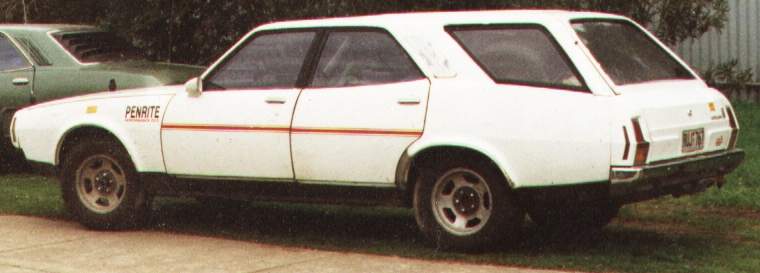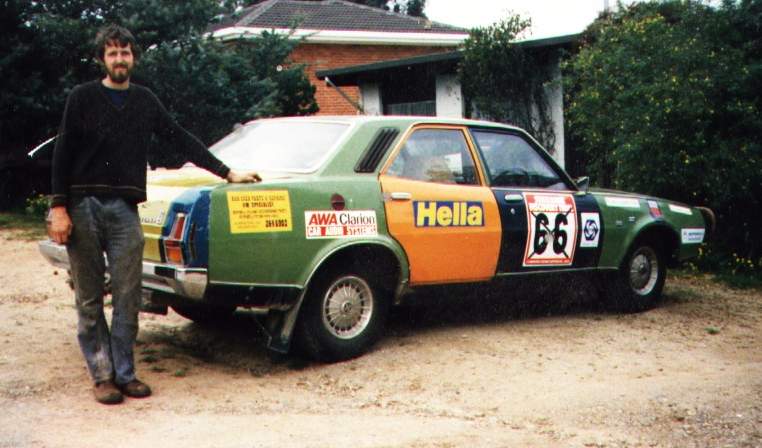South Australian Leyland P76 Owners Club - 2002 |
 |
Jilden
HOW TO BUILD A USEFUL P76 WAGON

- My need for a P76 wagon goes back a long way………
- My first car started it… It was a 1960 Fiat 1800 sedan, in which the front seat backs laid flat to form a padded cell sort of effect, enabling a family to camp in it when stuck in the Italian Alps perhaps…. My second car was a 1963 Fiat 2300 Wagon, which overcame the space deficiencies of the sedan. Its demise was assured because of chronic unreliability and rampant cancer, causing the ducting tape sealing the windscreen to tear each week. Then, my life was changed by … the P76. My first P76 lasted a few weeks, then I tried to shoehorn the motor into a Falcon XY wagon. While this project dragged on, my Fiat steadily deteriorated. So I bought a second P76 to run around in. Then, guess what? I grew to like the P76 so much that the Falcon project was axed!
- Over the next few years, I tried various concepts in conversions, including using two P76 sedan roofs together, and trying out a Valiant roof for size. None of these seemed to fit without major argument. Meanwhile I built my third P76, which I used to travel around Oz in 1985. I camped across the back seat, making a tent to cover the open back left door, putting my feet on the Esky with a cushion. It goes to say I was single at the time….
- I used to wander around car parks with a tape measure trying to find a roof which fitted well enough to work. I decided that the best deal was a Falcon XD type roof, but purchase of such a late model roof would have to wait for a while. Meanwhile, after 10 years my third P76 rusted away, and I built my current P., and got married. Then I saw an ad in the local paper…Rust free XE wagon for wrecking. There it was! I offered the guy free removal of the body when he had finished stripping it, and soon had it home.
- Project P76 wagon got started. First, the donor wagon roof was cut off, and placed on a spare P76 I had. Gee it was close! Then the P roof was cut out between the side rails, including the rail connecting the C pillars. Much trimming and shifting later, I seam welded the roof on. When installed, the roof had 90mm more head room than the Falcon it came off! Where the Falcon roof met the C pillars, I fabricated sheet metal to connect the two rails, and arranged an aperture for the back side windows. Then came the real test… could I make a tailgate? It turned out to be easier than I thought. The top half was the Falcon window, and the bottom was the boot lid, shortened. more careful trimming later, and it worked! The P76 boot lock held it shut securely. I had the start of a real wagon.
- Having cut out so much metal around the sides, the car was no longer rigid about the rear. So I added rearwards stiffeners level with the floor, a seam welded panel of 1.6 steel along the RHS chassis rail and vertical struts of 25x25 RHS under the new D pillars. Then I tested for torsional rigidity by jacking up the opposite corners of the car. With opposite wheels off the floor, the tailgate still closed easily. Putting weight on the towbar no longer caused flex at the middle of the tailgate.
- Next job was a level load floor. I noticed the boot lip was level with the floor over the diff, so I bent up ledges for a plywood floor to rest on. The back seat upright from the Falcon was tested for fit with the original P seat bottom in place. Much fine adjusting of the seat pivots eventually allowed the Falcon back with its closing panel (working like it should) to leave a flat floor longer than me, at about 2 metres long. The only trouble came with the realisation that the long wheelbase of the Falcon is so that the seat lays flat with the front seats right back. In my wagon version the front seats have to be moved forward a few inches to achieve this.
- I tidied the car up enough not to stand out in public by filling and painting the outside seams, and got the local glazier to cut some Perspex side windows. These I fitted with the original Falcon rubbers, cut down to length and silicone joined at the top front corners. The inside of the roof I covered with Commodore fuzzy lining, stuck on with spray-on contact cement. I left the edges loose so that the boffins could inspect the structure close up. Where the P76 boot seal met the Falcon tailgate seal, the gaps were sealed with pieces of foam pipe insulation, siliconed into place. Now I could test drive the hybrid on dark and rainy nights to see whether I had forgotten anything.
- Then made an appointment with a friendly engineer (known to the crowd who put V8's into EH Holdens legally). I took a swag of photo's of all the relevant constructional details, and waited , he came, and HE LIKED IT! For $300 he prepared a submission to the Government Inspector based on the following points:
- (1) The seat belt anchorages were essentially unchanged except where the C pillar connector was removed. He stated that the use of the Falcon roof satisfactorily replaced this.
- (2) The rear seat anchorages were either original Falcon or fabricated to a level in excess of standard.
- (3) The boot latch was acceptable as a tailgate latch.
- (4) The spare tyre remained in its original location.
- (5) The back windows were of a grade suitable for car windows.
- (6) Everything else was basically cosmetic!
- When the submission was accepted by the Government engineers I took in the wagon to be inspected. Apart from a thorough roadworthy check finding a few little faults, the inspection went without a hitch. I had chanced on an engineer who was well respected at the government garage, and a good inspector. He got the entire office staff to come out and look at it! Obviously they didn't get too many conversions like this.
- To cut a long story short, as soon as it was legally registered as a wagon, I jacked up the suspension, fitted 15 inch off road tyres, a sump guard etc. etc. and crossed the Simpson Desert with it. I've also travelled along many four-wheel-drive tracks in the Flinders Ranges, and proved to anybody watching what a P76 can do if you put your mind to it. When the wind outside has bowled everybody's tent half way to Coober Pedy, I snuggle into the sleeping bag in the back of my wagon and dream….
Jilden with his 1986 P76 Rally car

Jilden is well known in the P76 world with his knowledge of the car. He has written many Technical articles for the SA magazine as well for the web site.
Article written to the Sydney Morning Herald
Lemon Freshness
Apparently, Tony Davis of the Sydney Morning Herald (6th February 2003) still thinks calling the P76 a lemon is a great joke, surely to get a few donkey laughs from his fellow journalists.
What exactly does he mean by the word "lemon"? When someone who is too stupid to know better, picks a fresh lemon off a tree and bites into it, he pulls a face and swears you would be stupid to try one. Look into any drinks fridge, and what do you find? Drinks like Bitter Lemon, lemon, lime and bitters, lemonade and a host of others. Like lemons, P76's are an acquired taste, often by fixing minor problems like loose trim.
Anyway, any Sydneysider who knows a little about his history knows how important the humble lemon is to Australian History, Before 1770, many Pommy sailors died of scurvy, a Vitamin C deficiency, making it impossible for them to discover our continent. When a humble genius called James Cook insisted his crew get daily rations of lemon juice, not one sailor died of scurvy. This is in spite him travelling in his little wooden tub for far longer than any sailor before then. Our first language would probably be French, if it hadn't been for the humble lemon. It took the Pommy Navy many more years to get used to this idea, and then in their ignorance they confused lemons with limes. That's why they were called Limeys. Where does Tony Davis come from? I am an auto L.P.G. converter, and get to work on many of the plastic coated wank machines that get around today. Sure, many of them have lots of desirable features, offer stunning performance and do everything in perfect silence. BUT, if you want to fix one, you realise what a racket the car designers are up to. All parts are either hard to get to, expensive or just plain unfixable. Their testosterone-laden designers must laugh themselves sick every time they foist another car with snap-off head bolts and plastic vital parts onto an unsuspecting public. I am personally proud to drive a lemon. My personal P76 is capable of breaking speed limits anywhere in Australia (what isn't), is roomy, tows trailers well, is dead easy to fix, and I wouldn't swap it for any other car on the road. And, guess what, it's YELLOW. In 1986, I rallied this P76 successfully, showing people who value what their neighbours think of them that I don't give a damn for that kind of attitude. I won my division, by the way. (SA State Bank Discovery Trial, tour section) |
This site is hosted on
Freeservers  Reliable, Free Web Hosting |
Last updated March, 2007 |
This web site may contain Copyright material If you find any problems with the site, please email the Web Editor  |